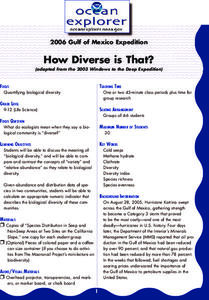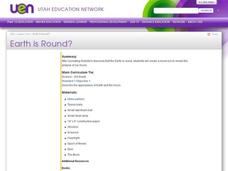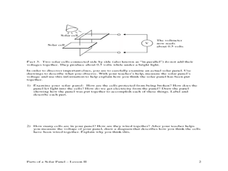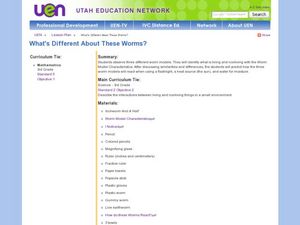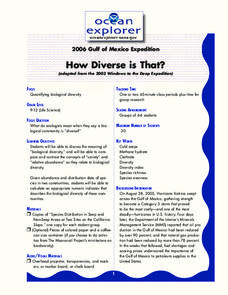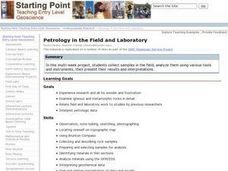Curated OER
Twice the Rice, or More?
Students review the metric and customary systems of measurement. In groups, they experiment with rice to discover the difference between the two systems. They record their observations on a worksheet and examine how capacity differs. To...
Curated OER
Chocolate Chip Cookie Mining
Students explore nonrenewable energy resources. In this coal lesson, students investigate how coal is formed and how it is used as a source of energy. Students mine for "coal" using toothpicks and chocolate chip cookies.
Curated OER
How Diverse is That?
After reviewing biodiversity, learners work in small groups to analyze actual species distribution data. They learn to calculate the Shannon-Weaver diversity index for different communities. Though not particularly engaging, the content...
Curated OER
We Care About Fire Safety
Students investigate the hazards of fires and how to best protect themselves and their family. In this home safety lesson, students examine the importance of a smoke detector and discover how many homes are missing them among their...
Curated OER
Web of Life - Role-Playing
Students role-play how organisms adapt to their environment. They play 20 questions with plant and animal habitats. They create a web of life to demonstrate how each plant and animal relies on the other for survival.
Curated OER
Earth is Round?
Third graders discuss how Aristotle concluded that the Earth was round. As a class, they review theories about the Earth's shape and describe how life on Earth would be different if it were flat. Individually, they make a moon book in...
Curated OER
Science Safari: Energy Resources
Students discover how scientific methods are integral to the creation of energy. In this energy resources lesson, students follow the provided procedures to learn how science impacts energy production.
Curated OER
What Did I Touch Today?
Students investigate germs and how they travel. They graph the places in the classroom that have been touch by students to determine which five places have had the most contact. They write stories from a germ's point of view.
Curated OER
Sprouting Scientists!
First graders observe and describe plants as they grow from seeds.
Curated OER
All Sorts of Seeds!
First graders compare seeds and explore how they are carried through the environment.
Curated OER
I'm So Bright, I Wear My Shades Indoors
Middle schoolers observe and draw energy using UV beads. They describe how light can be produced, reflected, refracted, and separated into visible light of various colors.
Curated OER
Zapped!
Fifth graders describe the behavior of static electricity as observed in nature and everyday occurrences.
Curated OER
What's the Matter? (Experiments)
Students observe a scientific discrepant event, and are then challenged to create experiments to solve the dilemma.
Curated OER
The Heat is On!
Fifth graders investigate evidence for changes in matter that occur during a chemical reaction.
Curated OER
How Big is a Dinosaur?
Fourth graders create enlarged replica of a stegosaurus drawing, using a grid to practice coordinates.
Curated OER
Move It, Sir Isaac!
Third graders analyze the work of Sir Isaac Newton as they investigate the laws of motion and force. Inertia is observed through a lump of clay.
Curated OER
Do Medicines Grow on Trees and Plants?
Students study the importance of preserving rainforest. They investigate the uses of rainforest plants for medicinal uses by participating in rainforest immersion activities.
Curated OER
Parts of a Solar Panel-Part II
Students discover how a mini-solar panel is constructed by behaving like detectives. Students examine an actual solar panel, measure the solar panel's voltage and use drawings to describe what they observe before completing questions...
Curated OER
Erosion: Slip Sliding Away
Fourth graders investigate the causes of erosion. Through several demonstrations including one using sugar cubes and warm water, they observe the effects of erosion. In groups, 4th graders conduct similar experiments and record their...
Curated OER
Why Does a Puddle Shrink?
Fourth graders describe the relationship between heat energy, evaporation and condensation of water on Earth. They compare evaporation rates when the back of the hand and an equal area of a paper towel are moistened with the wet swab.
Curated OER
Mr. Bo Jangle, What's Your Angle?
Third graders explore angles. In this geometry activity, 3rd graders identify and define acute, obtuse, and right angles. Students form angles with their bodies, find angles in picture books, and record angles found outside in their...
Curated OER
Three Worm Lesson
Third graders observe properties of three worms. In this living and non-living lesson, 3rd graders study characteristics of living and non-living worms. Students experiment to find how light, heat and moisture effects each of the worms....
Curated OER
How Diverse is That?
Students discuss biological diversity in ocean communities. In this diversity instructional activity, students examine the variety of organisms compared to relative abundance. They will write an analysis and discuss their findings with...
Curated OER
Petrology in the Field and Laboratory
Pupils collect samples in the field, analyze them using various tools and instruments, then present their results and interpretations. They examine igneous and metamorphic rocks in detail and interpret petrologic data.




